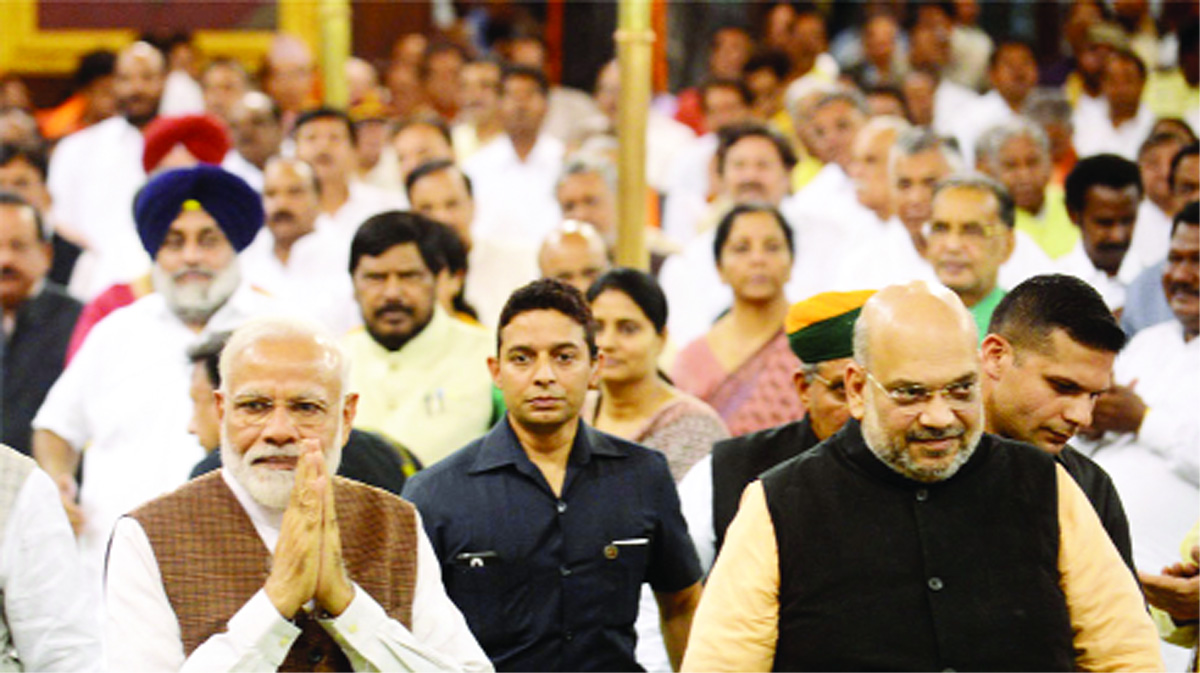Sahib Aggarwal
In 2014, the country witnessed a wave that came to be known as the Modi Wave. In 2019, this wave became a Tsunami. The reasons behind the rise of NDA in 2014 were multiple ranging from wide-scale corruption to overarching inflation, causing the fall in economic growth and thus, causing exasperation among the people of the country. The success of Modi’s Gujarat model, backed by his captivating communication skills, helped NDA to gain power in 2014.
Results of the 17th Lok Sabha elections marked a new chapter in the history of the Indian Government. The reasons behind the stupendous performance of BJP in recently concluded elections were not the same as in 2014. I want to sum up the six fundamental reasons that made this victory possible.
Rising India
India is a young country; more than 65 percent of its population is below the age of 35. In addition to this, the rising population of the middle class with new aspirations demands change for the better future of the country. Opposition failing to provide any satisfactory agenda on development failed to connect with the citizens of modern India, whereas, Modi with his rhetoric skills bonded at a deeper level. Moreover, various schemes introduced in the Modi tenure like Make in India and Smart Cities made people to repose their trust in him.
Social sector schemes
Schemes are established with the sole aim of delivering benefits to the citizens. NDA Government achieved this objective by commencing many such programs for the reformation of the social sector. To bring people under the purview of the financial inclusion and to introduce them to the formal lending sector they established the Pradhan Mantri Jan Dhan Yojana. To curb the unclean tag associated with India, the government launched Swachh Bharat Abhiyan, under which they tried to reduce open defecation by constructing toilets and addressing people to clean their localities. Pradhan Mantri Awas Yojana aimed to provide Pucca houses for the poor society. Similarly, they tried to provide LPG gas and electricity under Ujjwala Yojana, and Saubhagaya scheme to the BPL population and the list goes on. All these schemes helped and touched the core population, which rewarded NDA government with the mandate, which created history.
India’s foreign approach
“Modi ne videsh me desh ka namroshankia”, this was the slogan used by the NDA in Uttar Pradesh, and they were rightly so. Before, Modi, no Indian leader has enjoyed such world wide prominence. His efforts in making India to be accepted by the global community were quite evident, for instance, the USA which used to show staunch attitude towards Pakistan is now a strong ally of India. He became famous among the India Diaspora residing in different countries because he did not represent India with any artificial makeover. The balance showed by India in dealing with Israel and Palestine is another excellent example of India’s changing foreign approach.
Pakistan and China factor
India has to bear with not one but two troublesome neighbors. Under Modi’s administration, India deviated from its previous resolution approach of initiating dialogues and involving the global community; instead, it followed a strike back attitude. We witnessed a Retaliating approach in 2016 and 2019 after Uri and Pulwama attack respectively, where India paid back Pakistan with more robustness responding by way of Surgicalstrikes. India’s month-long standoff over Doklam with China and it’s rejection to join the OBOR initiative are furthermore instances of exhibiting its new method of dealing with its troubled neighborhood.
Failing opposition
Agenda of the opposition was not clear. Firstly, the campaign of UPA remained isolated to accusations without any solid proof. They came up with the Rafale deal controversy to which the Supreme Court accorded clean chit. Next, their campaign was more focused on degrading the opposition rather than focusing on their mandate. Rahul Gandhi’s tag line “Chowkidar Chorhai” had an opposite and undesirable effect to what it was intended. The Mhagathbandhan was an illusion, or we can say ”Situational Gathbandhan” without elucidation except dethroning Modi. Leaving aside, Tamil Nadu and Kerala, the opposition failed miserably to leave any mark.
Modi’s personal character
Ten years ago, liberals used to define him as an authoritarian, megalomaniacal, and communal whereas an ordinary citizen viewed him as self-made, strong, efficient, incorruptible, sincere, credible, and committed leader with strong leadership. His voice for the corruption-free governance, transparency, social inclusiveness and nationalism echoed among the people. Modi transformed from being a person to being an emotion for Indians. His efforts for the development were evident in various aspects of society for eg, India escalated in ease of doing business index from 142 in 2014 to 77 in 2019, pointing towards changing the business atmosphere inside the country.
Presently, a remarkable victory is achieved, yet the Modi Government will have to face many challenges ahead as every level has a new devil. On the economic front, there is a reduction in consumer-led demand due to which India is witnessing a slowdown. Simultaneously employment generation is more of a challenge presently than it ever was, thus reviving GDP growth should be our prime focus. On International platform, it will be interesting to see how India manages to remain unaffected by the ongoing trade war between USA and China on the one hand and by the geostrategic turbulence between USA and Iran on the other. Most, importantly, NDA must take its success more maturely and deliver the promises made in the last tenure before making any new ones as every rise has a downfall too.
(The author is an advocate High Court, Jammu)
feedbackexcelsior@gmail.com
Trending Now
E-Paper


